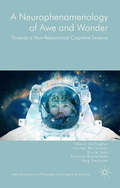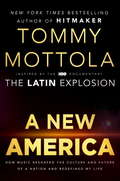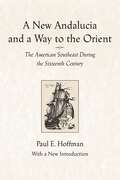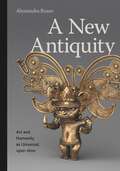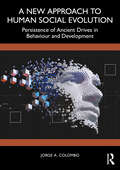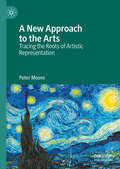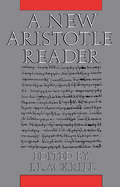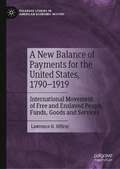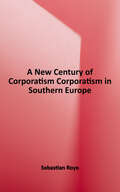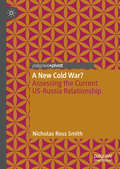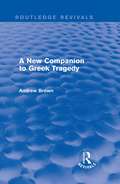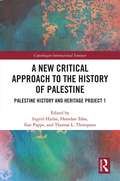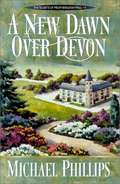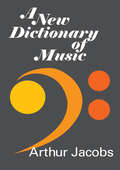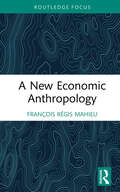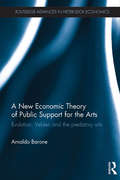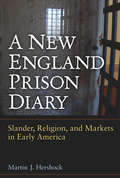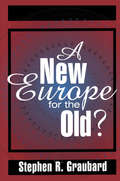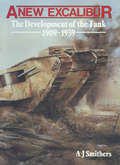- Table View
- List View
A Neurophenomenology of Awe and Wonder: Towards a Non-Reductionist Cognitive Science (New Directions in Philosophy and Cognitive Science)
by Shaun Gallagher Bruce Janz Patricia Bockelman Jörg Trempler Lauren ReinermanThis book presents a study of the various feelings of awe and wonder experienced by astronauts during space flight. It summarizes the results of two experimental, interdisciplinary studies that employ methods from neuroscience, psychology, phenomenology and simulation technology, and it argues for a non-reductionist approach to cognitive science.
A New Account of East India and Persia. Being Nine Years' Travels, 1672-1681, by John Fryer: Volumes I-III (Hakluyt Society, Second Series #20)
by William CrookeComposed in the form of letters and first published in 1698. This volume, edited with notes and an introduction, contains Letters I-III. Continued in Second Series 20 and 39. This is a new print-on-demand hardback edition of the volume first published in 1909.
A New America: How Music Reshaped the Culture and Future of a Nation and Redefined My Life
by Tommy MottolaThe long-anticipated companion book to the groundbreaking HBO documentary The Latin Explosion by renowned music producer Tommy Mottola. Legendary music mogul, entertainment impresario, and New York Times bestselling author Tommy Mottola explores and expounds on his lifelong love of Latin music, its influence on his life and career, and its ever-growing influence in America. Tommy Mottola discovered a passion for Latin music when he was a small child on the streets of the Bronx, where he fell in love with the energy and rhythm of the legendary Tito Puente. It is a love he carries with him to this day. In A New America, Mottola explores the societal and cultural impact the Latino community and its music has had on America by sharing behind-the-scenes stories from his own life and his connection to the Latin sound throughout the decades--from his initial fascination with Latin music, which started with Puente, to the mainstream success of Ritchie Valens, to the groove-laden guitar wizardry of Carlos Santana. Along the way, Mottola reveals heartfelt accounts of his longtime collaboration and friendship with Gloria Estefan and her husband, Emilio, the meteoric rise and tragic end of Selena, and his orchestration of the Latin Explosion of the 1990s, which launched megastars such as Marc Anthony, Ricky Martin, Shakira, and Jennifer Lopez. But A New America is more than a story about music and musicians. It is the story of a culture that continues to grow and influence America in all its aspects and an irresistible sound that continues to move and inspire the nation.From the Hardcover edition.
A New Andalucia and a Way to the Orient: The American Southeast During the Sixteenth Century
by Paul E. HoffmanPaul E. Hoffman's groundbreaking book focuses on a neglected area of colonial history--southeastern North America during the sixteenth-century. Hoffman describes expeditions to the region, efforts at colonization, and rivalries between the French, Spanish, and English. He reveals the ways in which the explorers' expectations--fueled by legends--crumbled in the face of difficulties encountered along the southeastern coast. The first book to link the earliest voyages with the explorations of the sixteenth century and the settlement of later colonies, Hoffman's work is an important reassessment of southern colonial history.
A New Antiquity: Art and Humanity as Universal, 1400–1600
by Alessandra RussoWe tend to think of sixteenth-century European artistic theory as separate from the artworks displayed in the non-European sections of museums. Alessandra Russo argues otherwise. Instead of considering the European experience of “New World” artifacts and materials through the lenses of “curiosity” and “exoticism,” Russo asks a different question: What impact have these works had on the way we currently think about—and theorize—the arts?Centering her study on a vast corpus of early modern textual and visual sources, Russo contends that the subtlety and inventiveness of the myriad of American, Asian, and African creations that were pillaged, exchanged, and often eventually destroyed in the context of Iberian colonization—including sculpture, painting, metalwork, mosaic, carving, architecture, and masonry—actually challenged and revolutionized sixteenth-century European definitions of what art is and what it means to be human. In this way, artifacts coming from outside Europe between 1400 and 1600 played a definitive role in what are considered distinctively European transformations: the redefinition of the frontier between the “mechanical” and the “liberal” arts and a new conception of the figure of the artist.Original and convincing, A New Antiquity is a pathbreaking study that disrupts existing conceptions of Renaissance art and early modern humanity. It will be required reading for art historians specializing in the Renaissance,scholars of Iberian and Latin American cultures and global studies, and anyone interested in anthropology and aesthetics.
A New Approach to Human Social Evolution: Persistence of Ancient Drives in Behaviour and Development
by Jorge A. ColomboThis book provides an important examination into the role of evolution of human traits of dominance as central to understanding social and political events, proposing a new view on human social evolution. It also examines basic biological universal needs and behavioural profiles of non- human living beings, from which humans share essential survival components. It invites readers to think critically about the psychological evolution of the human brain. Using comparative psychology, it argues that the core of human behaviour lies in the ancient, animal, universal set of survival resources hidden under various socialization profiles. However, it generally fails to replace drives of dominance and aggression for physical and social survival. Genuine replacement of those primal behavioural drives would require fundamental neuro- socio- behavioural changes. This book supports the thesis that without education and the promotion of universal values involving environmental protection and individual opportunities to evolve, there will be negative consequences for individuals and communities. This book represents a critical tool for students of behavioural sciences, anthropology, politics, and evolutionary neurosciences, and will also greatly benefit other readers, such as teachers and professional researchers.
A New Approach to the Arts: Tracing the Roots of Artistic Representation
by Peter MooreThis book considers how art actually works, how the various art forms connect with the world of ordinary human experience. Many books approach the subject from the top down, through topics such as the nature of beauty, the meaning of art, aesthetic judgement, and so on. The present book examines the subject from the ground up, so to speak, showing how the creation and appreciation of art spring from innate human needs and capacities. What we call ‘the arts’ emerge organically from the habitual activities through which human beings represent the world to themselves and others. Artistic representation, always more than mere imitation, is a reaching for the spirit of a subject, a revealing of the implicit, a refreshing of the overly familiar. A key idea is that art is representation through convention – that artistic conventions, far from inhibiting the work of the artist, are vital to artistic creativity.
A New Aristotle Reader
by J. L. AckrillIn a single volume that will be of service to philosophy students of all levels and to their teachers, this reader provides modern, accurate translations of the texts necessary for a careful study of most aspects of Aristotle's philosophy. In selecting the texts Professor J. L. Ackrill has drawn on his broad experience of teaching graduate classes, and his choice reflects issues of current philosophical interest as well as the perennial themes. Only recent translations which achieve a high level of accuracy have been chosen; the aim is to place the Greekless reader, as nearly as possible, in the position of a reader of Greek. As an aid to study, Professor Ackrill supplies a valuable guide to the key topics covered. The guide gives references to the works or passages contained in the reader, and indication of their interrelations, and current bibliography.
A New Balance of Payments for the United States, 1790–1919: International Movement of Free and Enslaved People, Funds, Goods and Services (Palgrave Studies in American Economic History)
by Lawrence H. OfficerThis book develops new balance of payments statistics for the United States from 1790 to 1919, before official statistics were kept. Part I of this book justifies construction of a new balance of payments table, and Chapter 1 surveys existing tables from that standpoint. Chapter 2 shows how this book overcomes the limitations of Office of Business Economics and its North-Simon-Goldsmith foundation. Specific features are highlighted, including measurement decisions, improvement of OBE series, development of new series, and derived implications for the structure of the US economy and for the importance of individual sectors that loom large at various times: slave trade, shipping, manufacturing, and travel. The book then generates new time series of the movement of people, the movement of goods, the movement of funds, and the provision of services. Part VI puts the new balance of payments table to use in several ways: aggregates and balances within the table, structure of the US economy, and specific sectors of the economy (slave trade, shipping, manufacturing, travel). Finally, Part VII provides concluding comments.
A New Century of Biology
by John W. Kress Gary W. BarrettIn the twentieth century, scientists in the relatively new field of biology played an important role in exposing the threats of environmental degradation, loss of species diversity, habitat fragmentation, scarce energy resources, and human population growth. In the essays found in A New Century of Biology, some of the world's most notable biologists consider how their discipline must evolve to address these problems in the twenty-first century. The next one hundred years, the contributors argue, will likely be dominated by breakthroughs in evolutionary biology and systems ecology; by an increased need for scientists to integrate research, teaching, and service missions; and by problem-solving ventures on greater spatial and temporal scales. Because human activity and increased population will continue to have a profound impact on the environment, biologists must define an effective strategy for integrating the biological sciences with global economics and human social structure.The eleven contributors are leaders in the fields of ecology, and evolution, morphology, and development, behavior, microbiology, ecosystem energetics and biogeochemistry, biodiversity and conservation biology, and human sciences. While acknowledging the real problems their discipline must address, they offer an optimistic agenda for the future.
A New Century of Corporatism?: Corporatism in Southern Europe--Spain and Portugal in Comparative Perspective
by Sebastian RoyoThe author examines how national-level social bargaining was established in Portugal and Spain during the last two decades, despite unpropitious institutional and structural conditions. He argues that this development was the result of the reorientation of the strategies of the social actors. With their support for these macro-economic agreements, labor unions sought to participate in labor and economic reforms and avoid the implementation of unilateral policies on the part of governments, while mitigating the decline in their bargaining power at the workplace level. <p><p>In addition, he contends that a process of institutional learning and increasing autonomy by unions from political parties, particularly in Spain, have further enhanced social dialogue and led the social actors to conclude that previous confrontational strategies were detrimental to the interests of their constituencies and threatened their own survival. The author claims that the emergence of new institutions to promote tripartite social bargaining in both countries resulted in the institutionalization of the bargaining process and contributed to a transformation in the pattern of industrial relations. Of particular interest to scholars and researchers involved with Iberian politics, labor, and political economy.
A New Chapter at the Little Penguin Bookshop: A heartwarming and uplifting World War Two novel about community, friendship and books
by Joanna ToyeNew stories are being written at The Little Penguin Bookshop…Carrie Anderson’s business selling books at her local train station is thriving and, with her beloved Mike returned from war, everything feels as though it is falling into place. That is, until Mike is sent to Washington as a liaison between Britain and America.When her twin brother, Johnnie, a fighter pilot, is injured, and her bookstall falls on hard times, Carrie misses the sage advice and comfort of Mike more than ever.Bolstered by her supportive station community, can Carrie battle through this challenging new chapter and reach the happy ending she deserves?Praise for Joanna Toye:'Romance, nostalgia, family, and books! The Little Penguin Bookshop has it all' Elaine Everest'Endearing characters [...] wartime loves, laughter and heartbreak' Annie Murray'A charming heroine, a dashing hero and books! I loved it!' Lesley Eames'An uplifting wartime saga with family at its heart' Tracy Baines'Meticulously researched and beautifully written' Helen Yendall
A New Christian Identity: Christian Science Origins and Experience in American Culture
by Amy B. VoorheesIn this study of Christian Science and the culture in which it arose, Amy B. Voorhees emphasizes Mary Baker Eddy's foundational religious text, Science and Health with Key to the Scriptures. Assessing the experiences of everyday adherents after Science and Health's appearance in 1875, Voorhees shows how Christian Science developed a dialogue with both mainstream and alternative Christian theologies. Viewing God's benevolent allness as able to heal human afflictions through prayer, Christian Science emerged as an anti-mesmeric, restorationist form of Christianity that interpreted the Bible and approached emerging modern medicine on its own terms.Voorhees traces a surprising story of religious origins, cultural conversations, and controversies. She contextualizes Christian Science within a wide swath of cultural and religious movements, showing how Eddy and her followers interacted regularly with Baptists, Methodists, Congregationalists, Catholics, Jews, New Thought adherents, agnostics, and Theosophists. Influences flowed in both directions, but Voorhees argues that Christian Science was distinct not only organizationally, as scholars have long viewed it, but also theologically, a singular expression of Christianity engaging modernity with an innovative, healing rationale.
A New Cold War?: Assessing the Current US-Russia Relationship
by Nicholas Ross SmithThis book examines the contention that current US-Russia relations have descended into a ‘New Cold War’. It examines four key dimensions of the original Cold War, the structural, the ideological, the psychological, and the technological, and argues that the current US-Russia relationship bears little resemblance to the Cold War. Presently, the international system is transitioning towards multipolarity, with Russia a declining power, while current ideological differences and threat perceptions are neither as rigid nor as bleak as they once were. Ultimately, when the four dimensions of analysis are weighed in unison, this work argues that the claim of a New Cold War is a hyperbolic assessment of US-Russia relations.
A New Companion to Greek Tragedy (Routledge Revivals)
by Andrew BrownThat the works of the ancient tragedians still have an immediate and profound appeal surely needs no demonstration, yet the modern reader continually stumbles across concepts which are difficult to interpret or relate to – moral pollution, the authority of oracles, classical ideas of geography – as well as the names of unfamiliar legendary and mythological figures. A New Companion to Greek Tragedy provides a useful reference tool for the ‘Greekless’ reader: arranged on a strictly encyclopaedic pattern, with headings for all proper names occurring in the twelve most frequently read tragedies, it contains brief but adequately detailed essays on moral, religious and philosophical terms, as well as mythical genealogies where important. There are in addition entries on Greek theatre, technical terms and on other writers from Aristotle to Freud, whilst the essay by P. E. Easterling traces some connections between the ideas found in the tragedians and earlier Greek thought.
A New Constitution Now
by Henry HazlittIn "A New Constitution Now," renowned economist and social thinker Henry Hazlitt presents a bold and thought-provoking critique of the American political system. Written during a time of great economic and political turmoil, Hazlitt's seminal work calls for sweeping constitutional reforms to address the inherent weaknesses and inefficiencies of the existing government framework.With incisive analysis and clear prose, Hazlitt examines the structural flaws that have led to governmental overreach, fiscal irresponsibility, and the erosion of individual liberties. He argues that the original Constitution, while revolutionary for its time, has been compromised by amendments and interpretations that have strayed from the Founders' intent. To rectify this, Hazlitt proposes a new constitutional convention aimed at restoring the principles of limited government, individual freedom, and economic stability."A New Constitution Now" offers a detailed blueprint for reform, including specific amendments and structural changes designed to enhance governmental accountability, reduce the influence of special interests, and protect the rights of citizens. Hazlitt's proposals are grounded in his deep understanding of economics, political philosophy, and the historical context of constitutional development.Throughout the book, Hazlitt emphasizes the urgent need for a vigilant and informed citizenry to engage in the process of constitutional renewal. He provides a compelling case for why such reforms are necessary not just for the preservation of liberty but for the prosperity and stability of the nation. His arguments are as relevant today as they were when the book was first published, offering timeless insights into the challenges of governance and the enduring quest for a just and equitable society."A New Constitution Now" is a clarion call for thoughtful and deliberate action to safeguard the future of American democracy. Hazlitt's visionary ideas and principled stance make this book an essential read for policymakers, scholars, and anyone concerned with the health and direction of the nation. It serves as both a warning and a guide, urging us to reconsider and revitalize the foundational document that shapes our lives and our liberties.
A New Critical Approach to the History of Palestine: Palestine History and Heritage Project 1
by Ilan Pappe Thomas L. Thompson Ingrid Hjelm Hamdan TahaA New Critical Approach to the History of Palestine discusses prospects and methods for a comprehensive, evidence-based history of Palestine with a critical use of recent historical, archaeological and anthropological methods. This history is not an exclusive history but one that is ethnically and culturally inclusive, a history of and for all peoples who have lived in Palestine. After an introductory essay offering a strategy for creating coherence and continuity from the earliest beginnings to the present, the volume presents twenty articles from twenty-two contributors, fifteen of whom are of Middle Eastern origin or relation. Split thematically into four parts, the volume discusses ideology, national identity and chronology in various historiographies of Palestine, and the legacy of memory and oral history; the transient character of ethnicity in Palestine and questions regarding the ethical responsibilities of archaeologists and historians to protect the multi-ethnic cultural heritage of Palestine; landscape and memory, and the values of community archaeology and bio-archaeology; and an exploration of the “ideology of the land” and its influence on Palestine’s history and heritage. The first in a series of books under the auspices of the Palestine History and Heritage Project (PaHH), the volume offers a challenging new departure for writing the history of Palestine and Israel throughout the ages. A New Critical Approach to the History of Palestine explores the diverse history of the region against the backdrop of twentieth-century scholarly construction of the history of Palestine as a history of a Jewish homeland with roots in an ancient, biblical Israel and examines the implications of this ancient and recent history for archaeology and cultural heritage. The book offers a fascinating new perspective for students and academics in the fields of anthropological, political, cultural and biblical history.
A New Dawn Over Devon
by Michael PhillipsUnearthing the Hall's ancient secrets Becomes Their Greatest Test of Faith Yet. In the Devonshire countryside of her childhood, Amanda Rutherford learns that it is never too late to recapture the treasures or youth. Heartbroken over past mistakes, her life begins to blossom in the sunshine of reconciliation, and she grows closer to the Gardener who tills the soil of every willing heart. The Great War is over. Yet in spite or the tragedy it visited upon them, the faith of the Rutherford family remains strong as they are now called upon to wrestle with new and unexpected challenges. Their quest for divine guidance leads to the discovery of the long-held secrets of Heathersleigh Hall, secrets that-to those with a heart of understanding-reveal the path of true discipleship.
A New Dictionary of Music
by Arthur JacobsWhat is a fugue? What is the difference between a saxophone and a saxhorn? Who besides Puccini wrote an opera called La Boheme? In what year, was the National Broadcasting Company Orchestra formed under Arturo Toscanini's direction? These and thousands of similar questions are answered in this comprehensive dictionary that remains unrivaled as a single-volume summary. A New Dictionary of Music is a basic reference work for anyone interested in music, whether performer or layman.It covers orchestral, solo, choral and chamber music, opera, and (in its musical aspects) the ballet. There are entries for composers (with biographies and details of compositions); works well known by their titles, such as operas and symphonic poems; orchestras, performers and conductors of importance today; musical instruments (including those of the dance and brass bands); and, technical terms. English names and terms are used whenever possible, but foreign terms in general use are cross-referenced. Particular importance has been attached to bringing the reader abreast of new musical developments.The composers and musical works chosen were those most likely to be encountered. Where an opera is given an entry, a brief explanation of the title follows. Similarly explication is provided for other works bearing literary or otherwise allusive titles. Among performers and conductors, only the following are included: those who, although dead, continue to be prominent through recorded performances (e.g. Gigli); the highest-ranking international artists of today, plus a very few apparently on the verge of attaining that rank; and, a few who, though not necessarily at the very head of their profession, are closely associated with composers in bringing out new works, or are conductors in charge of important orchestras.
A New Economic Anthropology (Economics and Humanities)
by François Régis MahieuTraditionally economic anthropology has been studied by sociologists, anthropologists, and philosophers seeking to highlight the social foundations of economic action. Meanwhile, anthropological questions have remained largely untreated in economics, despite the prominence given to the individual in microeconomics. And there is very little in the way of dialogue between the two sides. This book argues for a new economic anthropology which goes beyond the conflict of economics and anthropology to show the complementarity of the two approaches. Economics needs to go beyond the stage of homo oeconomicus and be open to broader ideas about the person. Equally, anthropology can be enriched through the methods and models of economic theory. This new economic anthropology goes beyond a simple observation of societies. It is new because it introduces the responsible person with a wider range of characteristics, in particular vulnerability and suffering, as a subject of economics. It is a particular interpretation of economic anthropology calling for a broadening of the subject (moving from the individual to the person), range of values (admission of negative values for altruism, social capital, responsibility), and disciplinary references. Through this approach, both economics and anthropology can be enriched. This book will be of great interest to those working in the fields of economics, anthropology, philosophy, and development studies.
A New Economic Theory of Public Support for the Arts: Evolution, Veblen and the predatory arts (Routledge Advances in Heterodox Economics)
by Arnaldo BaroneShould the arts receive public support? Can the arts survive in a modern capitalist society? Can economics shed light on the nature of public support, and whether there is a rationale for public intervention? This book undertakes to examine these questions as it explores the ways government and public resources are used to support the arts. This book applies a Veblenian approach to understanding economic development to investigate public support for the arts in an effort to determine whether this approach can elucidate economic rationales for public support. Divided into three parts, the first provides basic information on public support for the arts by surveying support in the United States and Australia. Part two includes a neoclassical overview of the topic while part three presents Veblen’s ideas on economic development. This book will be of interests to researchers concerned with cultural and institutional economics, as well as political economy.
A New England Prison Diary: Slander, Religion, and Markets in Early America
by Martin J. HershockIn 1812, New Hampshire shopkeeper Timothy M. Joy abandoned his young family, fleeing the creditors who threatened to imprison him. Within days, he found himself in a Massachusetts jailhouse, charged with defamation of a prominent politician. During the months of his incarceration, Joy kept a remarkable journal that recounts his personal, anguished path toward spiritual redemption. Martin J. Hershock situates Joy's account in the context of the pugnacious politics of the early republic, giving context to a common citizen's perspective on partisanship and the fate of an unfortunate shopkeeper swept along in the transition to market capitalism. In addition to this close-up view of an ordinary person's experience of a transformative period, Hershock reflects on his own work as a historian. In the final chapter, he discusses the value of diaries as historical sources, the choices he made in telling Joy's story, alternative interpretations of the diary, and other contexts in which he might have placed Joy's experiences. The appendix reproduces Joy's original journal so that readers can develop their own skills using a primary source.
A New Europe for the Old?
by Stephen R. GraubardSince 1989, it has been possible to review what has been published both at home and abroad on the communist states of Central and Eastern Europe and, no less importantly, on the Soviet Union itself, from a new perspective. Few have chosen to engage in this Herculean task, whether out of a residual civility in not wishing to mock certain aging scholars whose research would appear curiously dated, or out of a sense of fatigue with the whole subject of casting aspersions on mistaken views. "A New Europe for the Old?" asks whether the master narratives that circulated so widely in the West in the half-century since 1945 remain valid. Stephen Graubard's volume raises pertinent questions regarding the current state of the European world as it has evolved since 1989. He includes contributions from important scholars around the world: "A New Europe for the Old?" by Martin Malia; "The Serbs: The Sweet and Rotten Smell of History" by Tim Judah; "Illyrianism and the Croatian Quest for Statehood" by Marcus Tanner; "To Be or Not To Be Balkan: Romania's "Quest for Self-Definition" by Tom Gallagher; "Ukraine: From an Imperial Periphery to Sovereign State" by Roman Szporlunk; "Ethnic Nationalism in the Russian Federation" by Anatoly M. Khazanov; "Im Osten viel Neues: Plenty of News from the Eastern Lander" by Barbara Ischinger; "Discourse and (Dis)Integration in Europe: The Cases of France, Germany and Great Britain" by Vivien A. Schmidt; "The European Debate on Citizenship" by Dominique Schnapper; "Has the Nation Died? The Debate Over Italy's Identity (and Future)" by Darion Biocca; and "Postwar Europe" by Arne Roth. "A New Europe for the Old?" provides greater sympathy for the complexity of societies, and argues for greater balance of those that are small, and that do not cast a long shadow in the world today. In the 21st as in the 20th century, they may be engines of change, both as a result of the disorder that they produce as well as the ways in which their values, however seemingly antiquated, survive and prosper, and not only in their native lands. This volume should intrigue historians and European studies scholars alike.
A New Europe, 1918-1923: Instability, Innovation, Recovery (European Remembrance and Solidarity)
by Jay Winter Bartosz Dziewanowski-StefańczykThis set of essays introduces readers to new historical research on the creation of the new order in East-Central Europe in the period immediately following 1918. The book offers insights into the political, diplomatic, military, economic and cultural conditions out of which the New Europe was born. Experts from various countries take into account three perspectives. They give equal attention to both the Western and Eastern fronts; they recognise that on 11 November 1918, the War ended only on the Western front and violence continued in multiple forms over the next five years; and they show how state-building after 1918 in Central and Eastern Europe was marked by a mixture of innovation and instability. Thus, the volume focuses on three kinds of narratives: those related to conflicts and violence, those related to the recasting of civil life in new structures and institutions, and those related to remembrance and representations of these years in the public sphere. Taking a step towards writing a fully European history of the Great War and its aftermath, the volume offers an original approach to this decisive period in 20th-century European history.
A New Excalibur: The Development of the Tank 1909–1939
by A. J. SmithersThe story of the inventors, engineers, soldiers, and politicians behind the emergence of the armored fighting vehicle. The birth and infancy of the tank had an enormous number of technical problems to be solved—but the issues with its construction paled in comparison to the endless squabbles among the people involved. This fascinating study of the vehicle which was born out of the stalemate of the Western Front in the First World War looks at all the obstacles that had to be overcome. As is inevitable in almost any work of history set in the first half of the century, the figure of Winston Churchill looms large—but the role that he played in this instance is remarkable even by his standard, when it is remembered that at the crucial time he was First Lord of the Admiralty and theoretically had nothing to do with warfare on land. Foremost among the leading actors in the drama are Sir Eustace Tennyson-d&’Eyncourt, Sir Ernest Swinton, Bertie Stern, Sir William Tritton, and Walter Gordon Wilson. This is the first exhaustive study of the men behind the earliest tanks. The story of their furious quarrels and the machines they produced combine to make a remarkable and compelling study.
